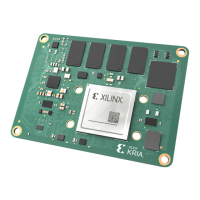During board-to-board inseron and removal, the installaon process should work within the
following recommended strain limits. The following gure shows the recommended locaons (E–
W, N–S) for a strain measurement on a carrier card. Diagonal strain should not exceed 500 micro-
strain during mang. Strain rate duraon taken to reach maximum 500 micro-strain should not be
less than four seconds. Based on experimental data, the maximum strain of 428 micro-strain
reached in 3.63 seconds duraon and was validated through dye and pry, where the sample
passed.
Figure 5: Recommended Locations for Strain Measurement on a Carrier Card
Board to Board Connector Distance Tolerance
Control
The distance between the mang ADM6 connectors on the carrier card must match the distance
between the ADF6 connectors on the SOM. The nal connector posion is dictated by auto-
placement machine accuracy and PCB pad posion tolerance. The way the distance is measured
between connectors is crucial to ensure seamless board-to-board mang, without applying
mechanical stress.
Chapter 3: Mechanical Design Considerations
UG1091 (v1.0) April 20, 2021 www.xilinx.com
Carrier Card Design for Kria SOM 43

